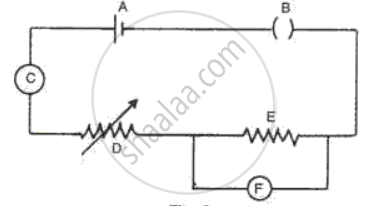Advertisements
Advertisements
प्रश्न
Calculate the current flowing through a wire of resistance 5 Ω connected to a battery of potential difference 3 V.
उत्तर
Potential Difference/Voltage (V) = 3 V
Resistance (R) = 5Ω
Current (I) = ?
According to Ohm's Law:
V = IR
Then I = `"V"/"R"`
I = `3/5`
= 0.6 A
APPEARS IN
संबंधित प्रश्न
Why are coils of electric toasters and electric irons made of an alloy rather than a pure metal?
Fill in the following blank with suitable words:
Resistance is measured in .............. The resistance of a wire increases as the length ..............; as the temperature ..............; and as the cross-sectional area .............. .
In a conductor 6.25 × `10^16` electrons flow from its end A to B in 2 s. Find the current flowing through the conductor (e = 1.6 × `10^-19` C)
What length of copper wire of resistivity 1.7 × 10-8 Ω m and radius 1 mm is required so that its resistance is 2Ω?
Fig. represents the circuit used for the verification of Ohm's law. Label the parts from A to F. state the function of each.

What is ohmic device?
Explain the equivalent resistance of a parallel resistor network.
The resistance of a nichrome wire at 0°C is 10Ω. If its temperature coefficient of resistivity of nichrome is 0.004/ °C, find its resistance of the wire at boiling point of water. Comment on the result.
Two conductors are made of the same material and have the same length. Conductor A is a solid wire of diameter 1 mm. Conductor B is a hollow tube of outer diameter 2 mm and inner diameter 1 mm. Find the ratio of resistance RA to RB.
Why should an ammeter have low resistance?
